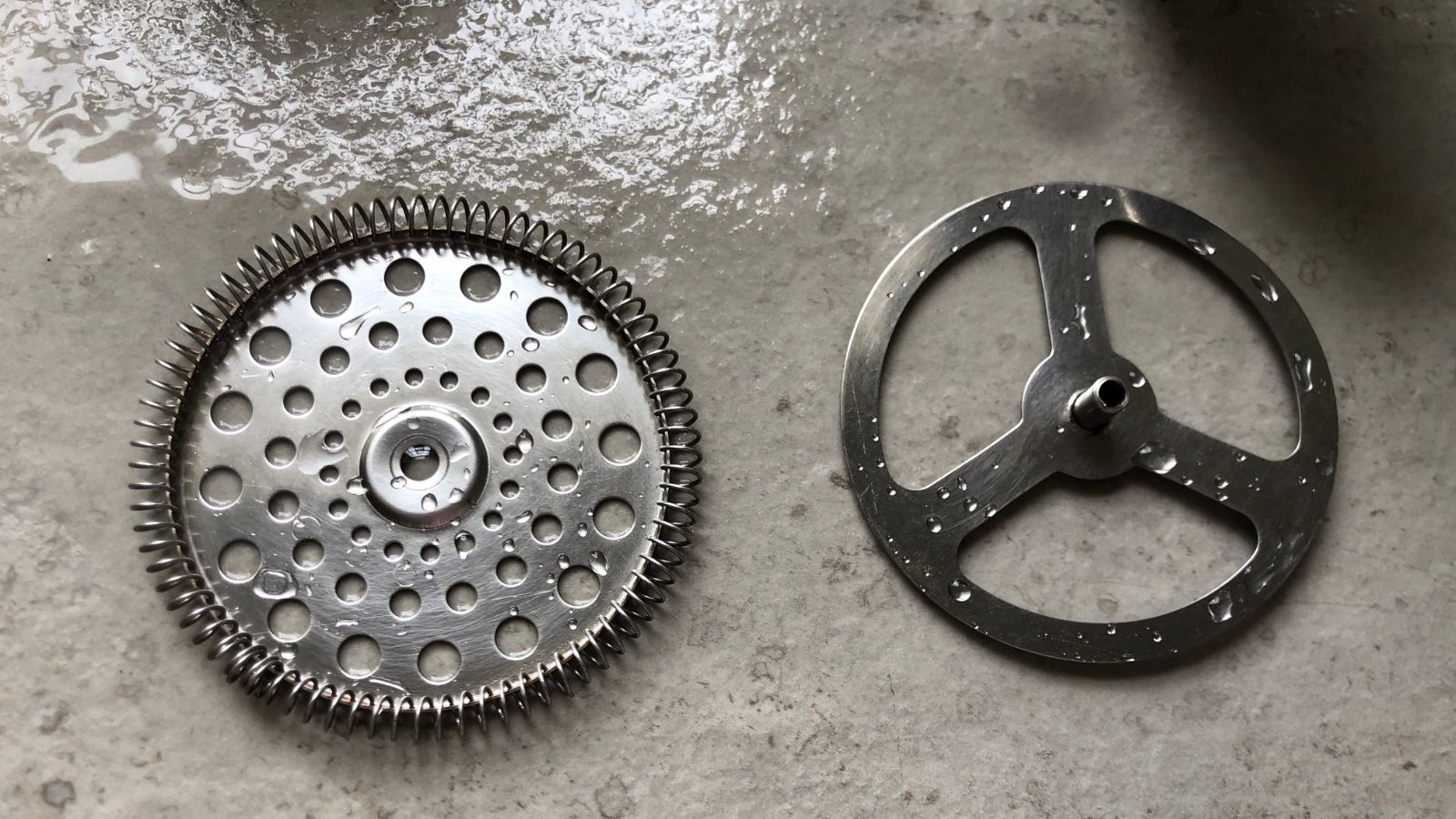How to clean a French press: cafetière-care tips from a barista
There are plenty of cleaning solutions sat in your storecupboard


An elderly French woman once told me how to clean a French press: pour the coffee grinds down the sink and only rinse the carafe with a little water. She was a wonderful friend to my grandmother, but utterly, utterly wrong. Cleaning your French press properly will keep your coffee café-quality for longer.
As a barista, I’ve cleaned up my fair share of coffee catastrophes. Whilst the French press requires more attention than a pour-over coffee maker, the clean up is still straightforward, especially when you know where to start.
I’ve gathered together the tips, tricks, and practices that have become muscle memory to me. You can rest assured that you’re looking after your favorite French press in the way that it deserves.
How to clean a French Press
It's a pretty simple process, but there are lots of pitfalls you might not know. Cutting corners can also harm your coffee in the long run. To start with the basics:
How often should I clean my French press?

Just like you would your coffee cup, saucepan, and plate, clean your French press after every use. So that the onerous task of cleaning doesn’t stop you from enjoying your coffee, I would recommend doing a little bit of cleaning prep before you brew.
Remove the plunger from the cafetiere, and fill your cafetiere up with some cold water. This stops your filter and plunger from sitting in wet coffee grounds, which will infuse, stain, and only become harder to clean the longer they sit in the grounds. If you practice this regularly, you should only need to do a deep French press clean once a week. This doesn’t need to be a drawn out process, but having a thorough cleaning session helps to remove stray coffee grinds, water residue and excess coffee oil. These remnants, if left to build up, can turn your cup of coffee into a bitter brew.
How do I clean my French press?

After you’ve enjoyed your coffee you’ll be left with grounds at the bottom of the carafe. I was once told that it is the proper French practice to pour these down the sink to clear the drains. It is not. Ground coffee beans can create blockages in your sink, so put them in the compost, food waste bin, or garbage.
Design expertise in your inbox – from inspiring decorating ideas and beautiful celebrity homes to practical gardening advice and shopping round-ups.
Use either a wooden or plastic spatula to reach in and loosen the grounds. You should then be able to shake most of the coffee grinds out. If you can't, don't worry. A few grounds won’t block your sink.
If this sounds messy to you, I like to use a fine sieve. After use, I half-fill my carafe with warm water. I leave the plunger in the sink to drain whilst enjoying my coffee. When it comes to cleaning, I tip the watery grounds into the sieve. This will get more of the grounds out of your carafe than a spatula, leaving you with an almost clean jug, but a sieve full of grinds. Once drained, these can be emptied into the bin or compost. It takes more time, but is a lot less frustrating than tapping around inside the carafe.

Next, using hot water and dishwashing liquid (our cleaning expert Millie Hurst recommends Ecover, available at Amazonor directly from Ecover), use a soft cloth or sponge to wash away any grounds and coffee remnants inside the carafe.
I fill the carafe with warm water and plunge the plunger as if I were making coffee. This normally frees the last of the stray grinds from hard-to-reach areas. Empty the carafe and rinse it well. Leave all the separated parts to dry, or use a microfiber cloth, being careful not to scratch the glass or metal, and dry the French press.

Can I clean my French press in a dishwasher?
Check the manufacturer’s guide, but an increasing number of French press coffee makers are dishwasher-friendly. As you did with hand washing, empty the coffee grinds from your French press. Then separate out the parts and place them onto the top rack of your dishwasher. If they are on the bottom rack, they might scratch, but they should be okay if your French press is too tall for the top rack. You can run the dishwasher as normal.
How do I deep clean my French press?

To get to the excess grinds and left over coffee oils, I would recommend doing a deep clean every week. Disassemble all of your French press. That means removing the cross plate (the bottom on the plunger), mesh filter, and spiral plate (the top part). Some rods can even be unscrewed from the lid. Rise these with warm soapy water, being careful of the filter. This can fray and become sharp. If possible, soak your filter and plunger parts in a dilution of water and white vinegar (4 parts to one) for a few hours, or, overnight. After they have soaked, rinse them in warm soapy water and allow them to dry before you reassemble them.

Do you have any tips for stubborn stains?

I reached out to the coffee community to find any alternative tried-and-tested methods for removing more stubborn coffee stains, flavors, and aromas. Most people used warm soapy water or a vinegar solution, but I did get some more unusual suggestions, such as using brown rice and shredded banana. Whilst I’m skeptical of using brown rice and shredded banana, there were some good alternative suggestions.
Kelsey Waddel, from Roasty Coffee, suggested adding coarse salt to hot water and using it to scrub the interior of the French press because it ‘can help remove stubborn coffee stains and buildup’. It acts as an abrasive, without risking deep scratches to your French press.

Kelsey lives and breathes, and writes about coffee, so has a thing or two to say about how to clean a French press. She works for Roasty Coffee, a website dedicated to delivering coffee content and is a devoted user of her French press.
Kelsey and a number of other experts also recommend using one tablespoon of baking soda, mixed with one cup of hot water, and leaving that in your French press for at least 30 minutes before rinsing thoroughly. This is a popular alternative to the vinegar technique I use, so it’s worth a try.
Another expert, Kathryn Henris, from Coffeenatics, suggested wiping the inside of the carafe with a slice of lemon or baking soda – it makes sense. Both lemon and baking soda are in a number of heritage cleaning hacks that feel reasonable to use on utensils that you drink from.

Kathryn has over ten years of experience with coffee, so she's well placed to advise on the best ways to clean your French press. She grew up surrounded by coffee, as her parents owned a coffee shop in Seattle. She has worked as a barista, coffee researcher, and owned a coffee shop for years.
FAQs
How should I store my French press?
Ideally, you should store your French press in its separate parts to avoid any damp being contained and becoming stale. In reality, I store my French press with the lid on and the plunger fully down. It’s more practical and I use it regularly enough that it doesn’t matter.
How can I keep my French press in good condition?
When cleaning, be delicate with the sponge and microfiber cloth. These are ways that it’s easy to scratch and make your French press look like it has been well-used. It’s best not to let the coffee sediment really settle into the bottom of your carafe, as it will integrate with the filter and become harder to clean. The less time it spends embedded in coffee grounds, the better. The key is to clean your French press, gently, regularly, and thoroughly.
I would recommend that you clean your French press regularly and by hand to minimize how damaged it becomes.
If the arduous task of French press cleaning is demeaning your caffeine kick, there are other options to consider. I compared the French press to a pour-over coffee maker, where the pour-over was the winner for ease of cleaning. However, I think the rich taste of French press coffee is worth every minute of hand-cleaning.

Laura is our eCommerce editor. As a fully qualified barista, she's our expert in all things coffee and has tested over thirty of the best coffee makers on the market. She has also interviewed Q-Graders and world-leading experts in the coffee industry, so has an intimate knowledge of all things coffee. Before joining Homes & Gardens, she studied English at Oxford University. Whilst studying, she trained as a master perfumer and worked in the luxury fragrance industry for five years. Her collection of home fragrance is extensive and she's met and interviewed five of the world's finest perfumers (also known as 'noses'). As a result of this expansive fragrance knowledge, she always puts quality and style over quantity and fads. Laura looks for products which have been designed simply and with thoughtful finishes.